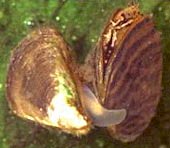Older stories on
Resources News
Links to general resource,
environmental sites
Links to non-profit
environmental/resource groups
Links to environmental/resource news
sources
E-mail Resources
News
Alien Invasions Cause Extinctions
Plants have no respect for international boundaries. Nor, for that matter, do zebra mussels, crazy ants or Nile perch. When alien species invade, they wreak havoc on economies and ecosystems across the globe. Curbing the problem is an international task, says Harold A. Mooney, a Stanford biologist who helped design a global plan to deal with the invaders.
Behind habitat destruction, alien invasion is the second greatest cause of species extinction worldwide. On islands, alien invasion is the number one cause of extinction.
When the small brown tree snake arrived on the coast of Guam, it entered an island with 13 species of forest birds, 12 types of lizards and three bat species. Today, only one bat species remains, three forest birds and six native lizard species.
The invasive, hardy water hyacinth strangled the ecosystem and economics of Lake Victoria in Africa until a multimillion dollar international control program was put into effect. Crazy ants form supercolonies in the rainforests of Christmas Island, changing the habitat and preying on the animals of the forest floor. The alien star thistle outcompetes native desert grasses of California.
The human propensity to travel, carrying plants, animals and bacteria, is essentially taking our ecosystems back some 200 million years, when the Earth consisted of a supercontinent called Pangea. During that era, plant seeds and animals could move freely across the land, since they were not yet separated by thousands of miles of ocean.
“We`re looking at designing something like the CDC [Centers for Disease Control],” says Mooney. “We need something comparable for invasive species.”
Mooney also believes that “if you import something, and it gets away, you should help pay.” He suggests adopting a type of bond, or insurance system, where those who do the importing contribute to a fund set aside to fight harmful invasive species.
Australia is one country that is already taking steps to address the problem of ‘alien invasions’. Scientists and quarantine authorities are preparing to cast a virtual net around their island continent in a blockade against invasive marine species lurking in a thousand ports around the globe. The virtual net is in the form of the world's first ballast-water risk assessment plan for marine biological security designed to keep out invaders. The system considers factors such as ballast water origin, species risk and vessel risk, the potential for species to survive the journey, and tolerance to local port conditions.
"Effectively, we are creating the webbing which is the scientific basis for authorities to throw a net around the country," says Dr. Hayes, a marine scientist from the Australian national science agency, CSIRO. "In this project we have worked to translate the well-developed principles of industrial risk assessment and consider their use in the marine environment. The intention is to evaluate the risks from potential bio-invasions and then apply all the systems we know of to shrink the mesh and keep out unwanted visitors."
There are 170 known species now resident in Australian coastal waters. Fourteen of these are rated introduced pest species because of their potential to modify the marine ecosystem. One is the black-striped mussel that arrived in Darwin in 1999 and is related to the zebra mussel that has invaded many areas of North America over the past several decades. Management authorities in the Northern Territory were successful in ridding Darwin Harbour of the species using a 120 tonne chemical cocktail. The mussel is still arriving in Australia as a fouling organism on foreign fishing vessels fishing illegally in Australian waters.
